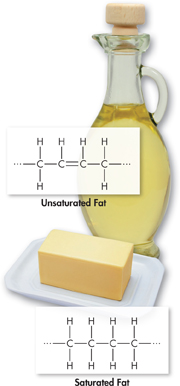Fats Because our society places great emphasis on a trim appearance, the word “fat” has a bad reputation. But fats, or lipids, are an important part of a healthy diet. Fats help the body absorb fat-soluble vitamins and are a part of cell membranes, nerve cells, and certain hormones. Deposits of fat protect and insulate body organs and are a source of stored energy.
Fats usually form when a glycerol molecule combines with fatty acids. Some of these acids, called essential fatty acids, cannot be made in the body and are needed to perform many of fat's functions. Based on the structure of their fatty acid chains, fats are classified as saturated or unsaturated. When there are only single bonds between the carbon atoms in the fatty acids, each carbon atom has the maximum number of hydrogen atoms and the fat is said to be saturated. Most saturated fats, such as butter, are solids at room temperature.
BUILD Vocabulary
PREFIXES The prefix poly- is Greek for “many.” Polyunsaturated fats contain more than one double bond. The prefix mono- means “single.” Monounsaturated fats, such as olive oil, contain only one double bond.

FIGURE 30–6 Fats At room temperature, most saturated fats are solid and most unsaturated fats are liquid. Saturated fats have been tied to many health problems. Consuming limited amounts of unsaturated fats, such as those found in avocados and olive oil, may have some benefits.
Unsaturated fats have one or more double bonds between carbon atoms, which reduces the number of hydrogen atoms in their fatty acids. Unsaturated fats are usually liquids at room temperature. Because many vegetable oils contain more than one double bond, they are called polyunsaturated.
Food manufacturers often modify unsaturated fats in vegetable oils by adding hydrogen to them. These processed fats are called trans fats. Trans fats are solid at room temperature and have a longer shelf life than unsaturated fats. However, recent studies suggest that trans fats may be associated with serious health concerns, including heart disease.
Proteins Proteins have a wide variety of roles in the body. Proteins supply raw materials for growth and repair of structures such as skin and muscle. Many enzymes that control cellular chemistry by increasing the rates of chemical reactions are made of proteins. Proteins also have regulatory and transport functions. For example, the hormone insulin is a protein that regulates the level of sugar in the blood. Hemoglobin, a protein found in red blood cells, helps transport oxygen. Proteins can also be used as energy sources when other nutrients, such as carbohydrates and fats, are in short supply.
Proteins are polymers of amino acids. The body is able to synthesize only 12 of the 20 amino acids used to make proteins. The other eight are called essential amino acids. Essential amino acids must be obtained from the foods that you eat. Foods shown below, such as meat, fish, eggs, and milk, generally contain all eight essential amino acids. Foods derived from plants, such as grains and beans, do not. People who don't eat animal products must eat a combination of plant foods, such as beans and rice, to obtain all of the essential amino acids.
Table of Contents
- Formulas and Equations
- Applying Formulas and Equations
- Mean, Median, and Mode
- Estimation
- Using Measurements in Calculations
- Effects of Measurement Errors
- Accuracy
- Precision
- Comparing Accuracy and Precision
- Significant Figures
- Calculating With Significant Figures
- Scientific Notation
- Calculating With Scientific Notation
- Dimensional Analysis
- Applying Dimensional Analysis




